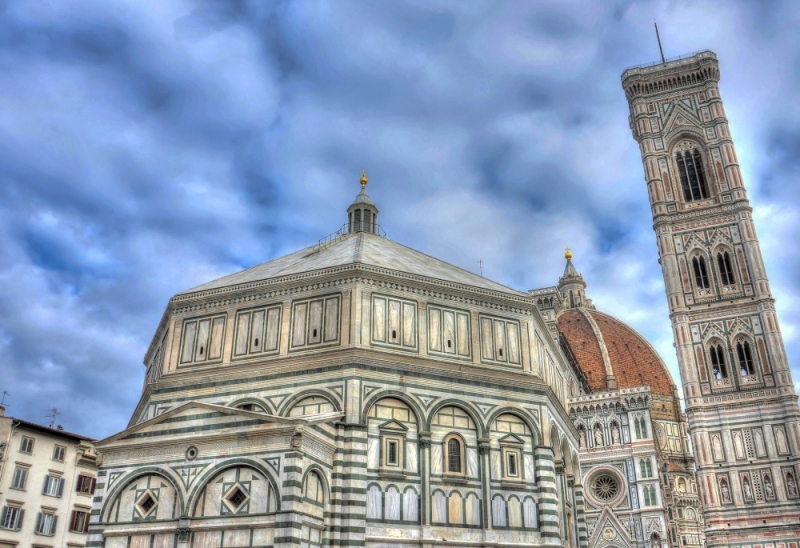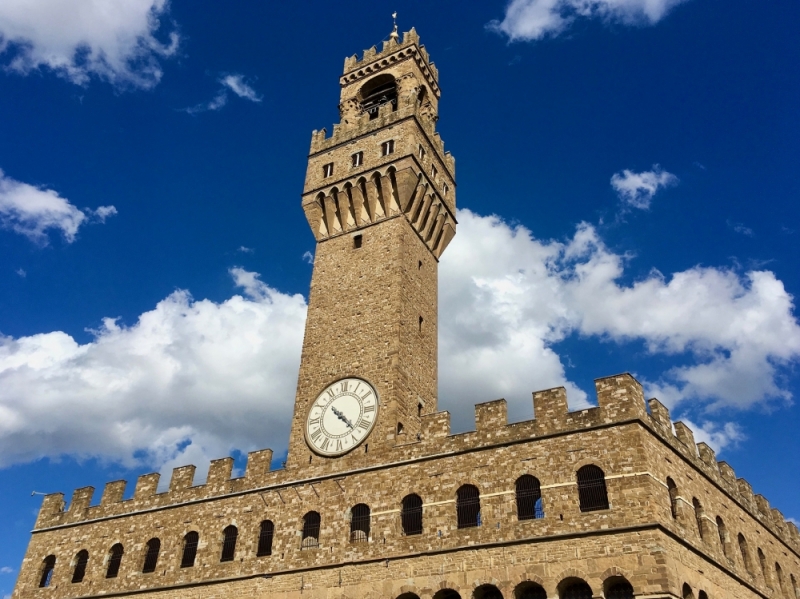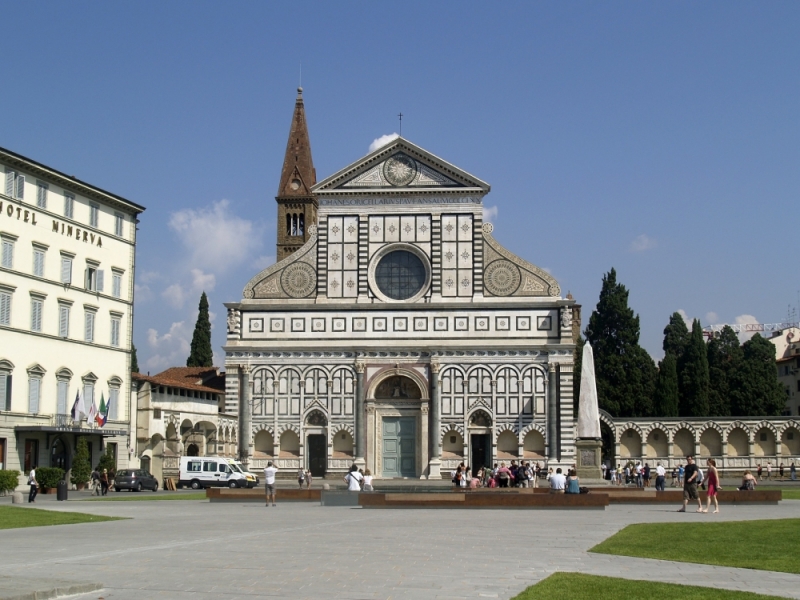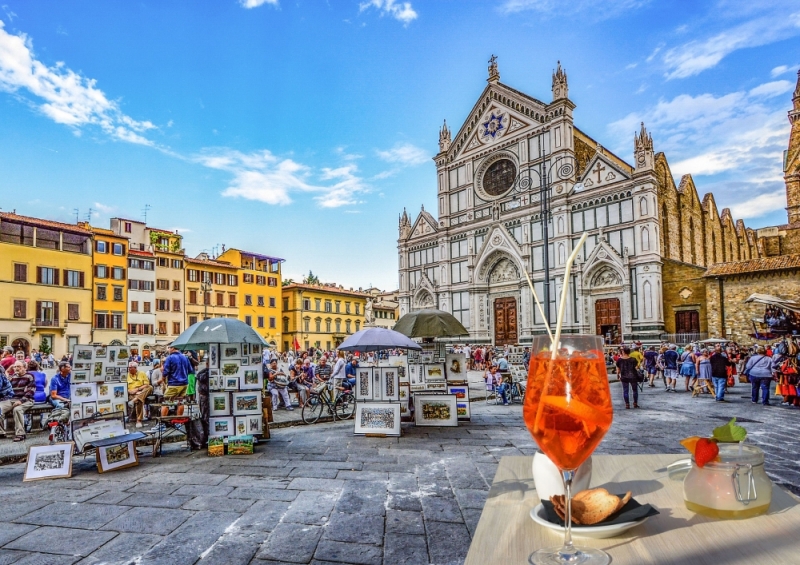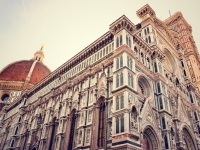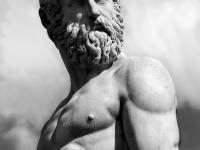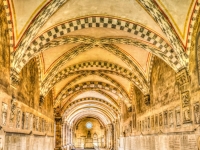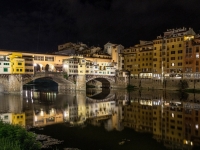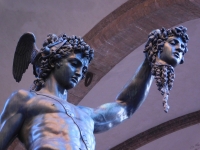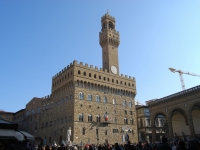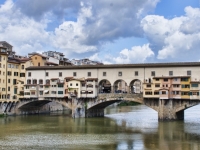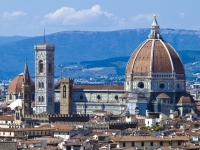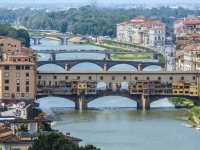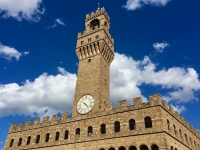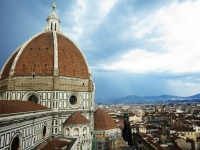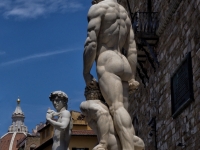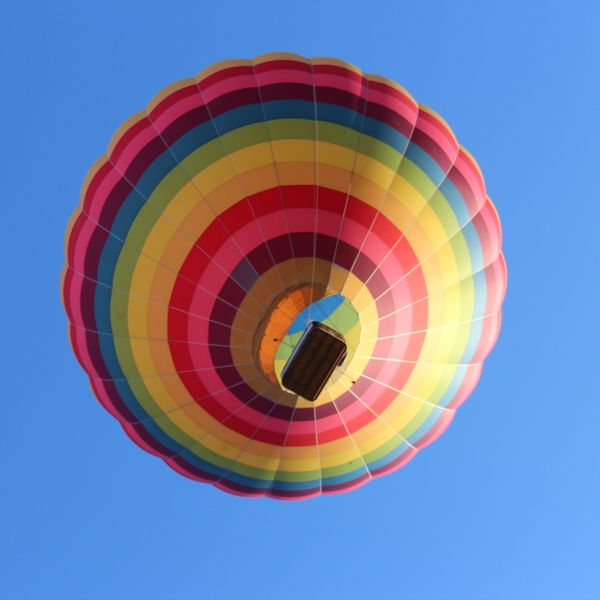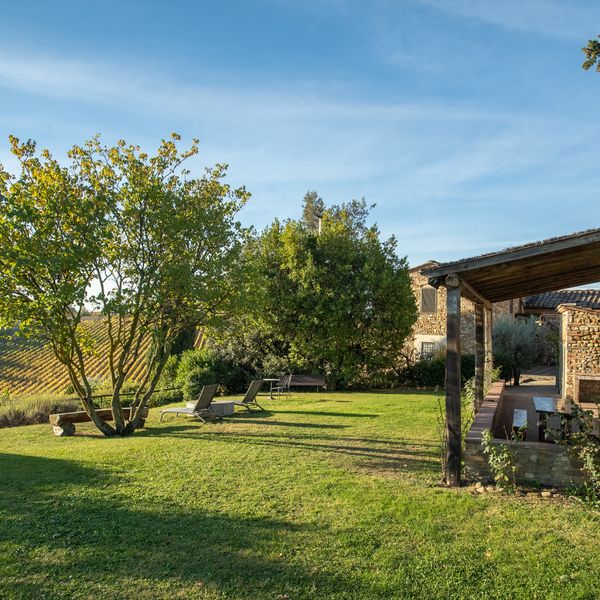Florence and its origins
Florence is the home of artists, bankers and humanists, a symbol of Humanism and the Italian Renaissance. It was probably founded in the 10th century BC by the Villanovans and later became the home of the Etruscans, who lived in a nearby village, called Fiesole. In fact, evidence of Etruscan civilization dating back to the 9th century has been found. BC It is possible to admire the remains of Etruscan art in the Archaeological Museum, among which there is also the famous Bronze of the Chimera. Some of them settled near the Arno river, which allowed the movement of goods. The Romans later decided to occupy this strategic position, so as to be able to keep both the river and the Via Cassia under control. The city, with the affirmation of Roman supremacy, began to acquire prestige in the 12th century, thanks to its trade. It later became a bishopric, becoming part of the Duchy of Lucca, under the dominion of the Lombards. It was thanks to Charlemagne that it managed to regain its independence and become a county. It became a free municipality, thanks to Countess Matilde of Canossa and, through autonomy, acquired power over the nearby cities of Pisa, Pistoia, Siena and Arazzo. Florence had its rise precisely in the municipal age, becoming an imposing power, as attested by the introduction of the gold florin onto the international market. Numerous civil struggles marked the city, particularly those between the pro-papal Guelphs and the Ghibellines, opposed to the power of the Church. These political struggles were a clear reflection of the contrast that existed between different social groups: that of the major arts, which represented rich merchants and bankers, that of the minor arts, representing the small artisans and the spokesmen of the feudal nobility, called magnates. At the head of the city were merchants and bankers, despite the attempts by the humbler classes to reclaim power, such as that of the Ciompi riot, which was immediately quelled. In 1348 the plague exterminated a large part of the population, and the failure of banking houses, such as that of the Bardi and the Peruzzi, gave rise to a period of great economic and financial crisis. At the end of the century, Florence was committed to preserving its independence under the pressure of the Viscontis, who aspired to political primacy in Italy. The transition from the municipal age to the age of lordship occurred in the fifteenth century, with the arrival of the Medici. The Medici affirmed their power in 1434, after the Pazzi conspiracy, when Lorenzo the Magnificent came to power, who maintained political stability by allying himself with Milan and Naples. During this period Florence earned the nickname "second Athens", with an unparalleled cultural and artistic growth. Following the death of Lorenzo, the city briefly returned to being a republic, and the Dominican friar Girolamo Savonarola took control of it, who, after being condemned by Alexander IV as a heretic, burned at the stake. After a period of instability, the Medici restored their power. Starting from 1569, with the rise to power of Cosimo I, Grand Duke of Tuscany, the city state became a regional state. Having become part of the kingdom of Piedmont in 1860, the grand duchy was annexed to the kingdom of Italy, and Florence became its capital from 1865 to 1871. The Second World War destroyed much of the city's artistic heritage, and, following the bombings of the Germans , only the Ponte Vecchio remained unscathed.
What see
As mentioned above, Florence was the cradle of the Renaissance, so there is so much to visit. We will draw up a short list, in order to advise you on the must-see attractions
Piazza Duomo
1) Piazza del Duomo: the square is a real open-air museum that includes Brunelleschi's Dome, the Cathedral of Santa Maria del Fiore, Giotto's Bell Tower, the Baptistery of San Giovanni, the Crypt of Santa Reparata and the Museo dell'Opera del Duomo. In fact it is possible to visit the whole square with just one ticket.
2) Ponte Vecchio: it is the most famous bridge in the world. In fact it was the only bridge to save itself from the 1944 German bombing. Today it is possible to find goldsmith shops, which attract tourists from all over the world, but once on the bridge vegetable and butcher shops excelled. Following the construction of the Vasariano corridor of the Uffizi, the vegetables were driven out in favor of the goldsmiths.
Palazzo Vecchio
3) Palazzo Vecchio: the palace is so large and majestic that it cannot be photographed. It is one of the greatest examples of fourteenth-century civil architecture in the world. With its grandeur, the "tower of Arnolfo", 94 meters high and built around 1310, appears. At the entrance of Palazzo Vecchio it is possible to admire a copy of Michelangelo's David. This beautiful building is located in the center of Piazza della Signoria, once a battleground between the Guelphs and Ghibellines, today a charming square and meeting place.
4) Uffizi Museum: it is a den of works of art and a destination for art lovers from all over the world. At the entrance you will be fascinated by the works of art of the fourteenth century and the three altarpieces by Cimabue, Duccio di Buoninsegna and Giotto, depicting "The Madonna Enthroned with the Child". Continuing you will find works by Botticelli, Leonardo, Signorelli, Perugino, Durer, Caravaggio and ... many others!
Brancacci Chapel
5) Brancacci Chapel: the Brancacci Chapel, located inside the Church of Santa Maria del Carmine, is one of the most famous examples of Renaissance painting. It is the result of the collaboration of two painters, Masaccio and Masolino da Panicale, to which must be added the intervention of Filippino Lippi, who completed the work about fifty years later. The main theme of the fresco is that of the historia salutis and tells the story of original sin, starting from original sin, up to the intervention of Peter.
6) The Basilica of Santa Croce : visiting the first part of the basilica we find the tomb of Michelangelo and the tomb of Galileo Galilei. Later it is possible to find Dante's cenotaph, but not his remains (kept in Ravenna, where he died in exile). There are also the tombs of Vittorio Alfieri, Antonio Canova, Niccolò Machiavelli, Gioacchino Rossini and Ugo Foscolo, who defined Santa Croce as a place that kept the "urns of the Forts". But there are not only urns: in fact continuing there are the chapels frescoed by Giotto and in the Pazzi Chapel the Cimabue Crucifix is preserved.
Santa Maria Novella
7) Church of Santa Maria Novella: it was built by order of the Dominican friars in 1278 and is the perfect representation of the "Tuscan Romanesque", with white, black and green marble cuttings. Inside you will be immediately captured by Giotto's Crucifix. Continuing the visit, you can admire the frescoes by Filippino Lippi. The best known work is Masaccio's Trinità, a true artistic revolution. It is interesting because the figure of the Madonna does not look at the child who is dying, but indicates the viewer of the painting, conscious of the destiny that must be fulfilled for the salvation of man.
8) Accademia Gallery : it was built in 1874 at the behest of the Grand Duke Pietro Leopoldo in order to show the students of the academy of fine arts, the models of Florentine art. Among the most famous works, we find Michelangelo's David, which was previously exhibited in Piazza della Signoria. The statue represents the giant Goliath and is the symbol of the victory of intelligence and courage in the face of brute force. The David symbolizes perfection and eternal beauty.
Movida and entertainment
The city offers numerous opportunities for those who want to have fun. Florence is certainly a prestigious cultural center, but despite the rich artistic heritage, in Florence there is a decent nightlife with numerous bars, pubs and discos. Night entertainment ranges from discos to wine bars. Near Piazza della Signoria and in the Oltrarno area, you will find many interesting places. Being a cultural center, it also hosts numerous events such as concerts, live performances or live music evenings starting from jazz, up to blues and soul. An unmissable event is the Maggio Musicale Fiorentino at the Florence opera. Most nightclubs are located near the historic center. The nightclubs in the center of Florence tend to be small and intimate, the Oltrarno area is quieter and more romantic, while going towards Piazza della Signoria the atmosphere is refined. Among the clubs we find: Florence Jazz Club open from Sunday to Thursday from 11.00pm to 3.00am, Friday and Saturday from 11.00pm to 4.00am. it's a stop not to be missed, especially for music lovers. To enter you must make a membership card at the cost of 6 euros, which has an annual value. Tenax, open Friday and Saturday from 22:00 to 4:00. It is a historic disco that generally offers house and electronics, but also hosts international talents. Yab Disco Club Restaurant, open Monday and Wednesday to Saturday from 19:00 to 4:00. It is a place that surprises for its aesthetic care: the entrance is rich in mirrors and the dance floor is animated by plays of lights. Dolce vita open from Sunday to Wednesday from 7.00pm to 1.30am and from Thursday to Saturday from 7.00pm to 2.00am. It is certainly a trendy place, and it is possible to have an aperitif with a view of Piazza del Carmine, while after dinner you can let loose when the disco opens. Among the bars are the Café de Paris , elegant and refined, the Slowly Cafè where international or other dishes will be offered such as the Baraka Cafè where you can enjoy an aperitif accompanied by a pleasant background of jazz music.
Climate, curiosity and advice:
The climate of Florence is a temperate and humid climate with very hot summers. The wettest month is November, while the driest month is July. The average annual humidity is around 70%.
Curiosity: going into via de 'Cerretani, a petrified head appears from the wall, it is the Berta, probably of Roman construction. According to some scholars, it seems to have been there since 1326 due to a curse thrown by an astrologer condemned to death. According to others, it is a fruit vendor who gave the church a bell in order to warn workers of the opening or closing of the city gates.
Looking carefully at the side of the Duomo of Florence, you can see the head of a bovine. In this regard there are two legends: the first seems to be a tribute to the trawlers who collaborated in the construction of the church; the second describes the bull as a testimony of treason. In fact, there was a carpenter who worked inside the cathedral, who had an extramarital affair with the baker's wife who worked nearby. The baker denounced them and the two had to leave. To get revenge, the carpenter put the bull's head at a point where the baker could see it, so as to remind him every day that he was horned. Another rather bizarre curiosity concerns a balcony built in reverse. It seems that in Borgo Ognissanti a balcony was built different from the others: in fact its architectural elements were built in reverse. The cause seems to be a misunderstanding that occurred between the landlord, whose name was Baldovinetti who wanted to have an important balcony, and Alessandro de 'Medici, at the time the lord of Florence, who forbade too conspicuous elements through an ordinance. The lord Baldovinetti insisted that Alessandro de 'Medici give him the concession and Alessandro, trying to discourage him, told him that he could build it, but only on the contrary. It seems that Mr. Baldovinetti had won it.
Tips: if you want to visit Florence, come back a bit of history! Florence is a city so rich in history that it would be a shame to turn it around and miss some works of art. If you have to choose when to go to Florence, avoid going there in summer, as temperatures can reach up to 38 degrees and, of course, you should book museum tickets in advance.


